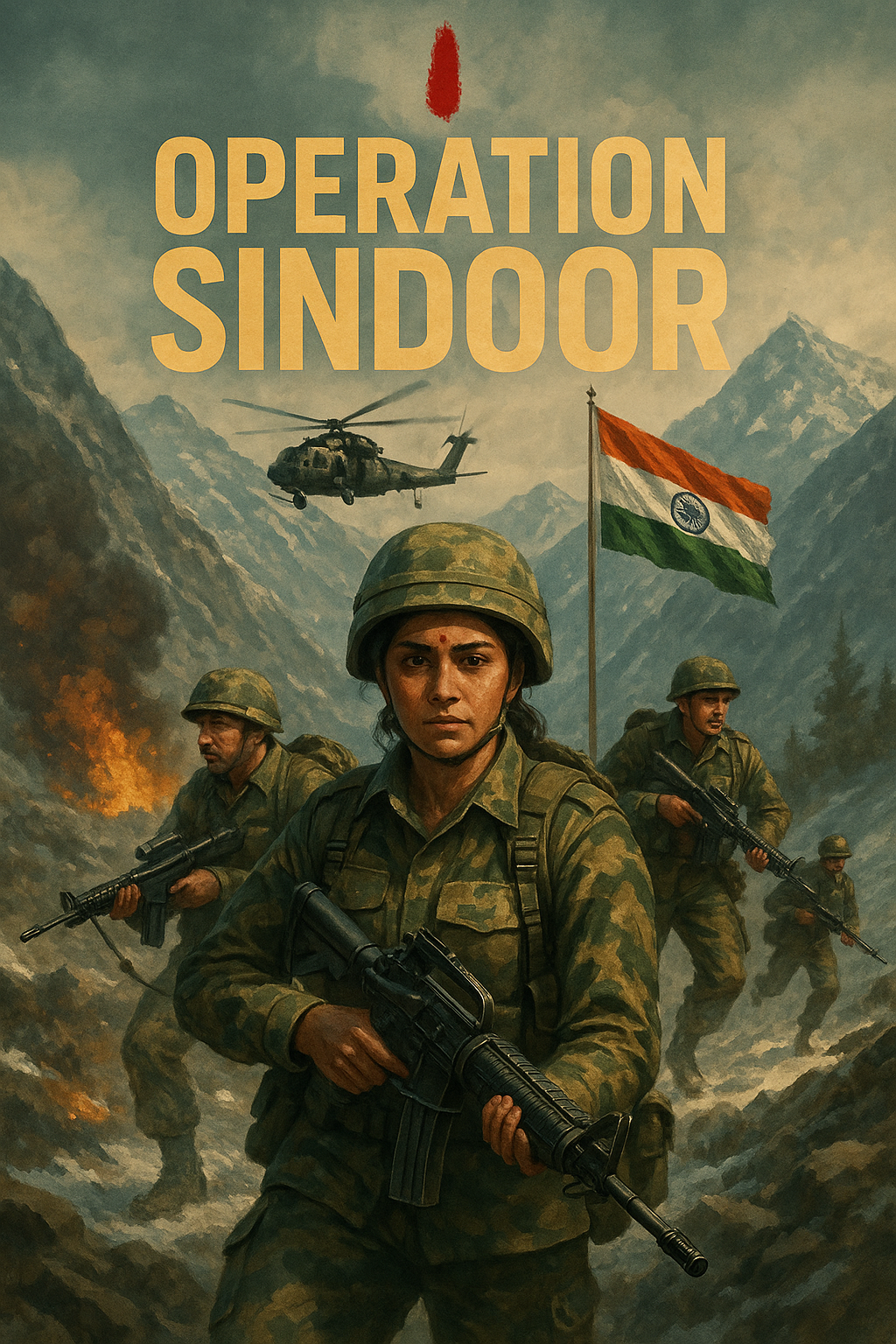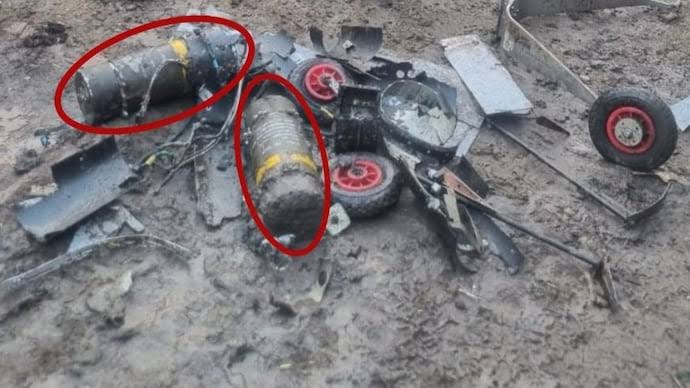OPERATION SINDOOR
Operation Sindoor was a covert Indian military mission launched in 2025 to dismantle a deadly terror syndicate in North Kashmir. The trigger was a brutal attack on army families, where women and children were killed. The operation aimed to eliminate militant leadership, rescue hostages, and recover intelligence. Evidence of foreign support, especially from Pakistan and Turkey, was uncovered. The mission was swift, lasting 43 hours, and was a major tactical success. It symbolized vengeance, sacrifice, and national pride.




- Detailed Theory on Operation Sindoor :
In early 2025, the Indian intelligence community intercepted a series of encrypted communications between foreign handlers and militant commanders operating deep within the Kashmir Valley. These transmissions, marked by unusual frequency and coded urgency, pointed to the emergence of a powerful, foreign-backed insurgent network planning a synchronized assault on military and civilian infrastructure. The situation escalated drastically when terrorists ambushed a military convoy in the Kupwara region, targeting unarmed family members of Indian soldiers returning from a school event. The attack killed several women and children, including a decorated female officer, whose blood-soaked sindoor became a haunting image across national media. That image ignited the resolve for an unprecedented mission—Operation Sindoor.
---
Strategic Goals Behind the Curtain
Operation Sindoor was not just a counterinsurgency operation; it was a multi-layered strategic response to a growing hybrid warfare threat. Indian defense planners realized that the new militant wave was not merely local—it was orchestrated by an alliance of foreign intelligence networks, specifically Pakistan’s ISI, with logistical and technical support from Turkey and Qatar. These nations, under the guise of humanitarian missions and religious solidarity, had quietly funneled advanced drones, encrypted satellite devices, and radical ideological training into Kashmir. The goal was to create a semi-autonomous Islamic zone in northern India and spark mass civil unrest. India had no choice but to respond decisively, yet silently.
---
Planning the Unseen War
The operation was planned in utmost secrecy by a joint cell of RAW, Indian Army Intelligence, and the National Technical Research Organisation (NTRO). Code-named “Sindoor” to honor the fallen officer and to signify a mission of sacrifice and rebirth, it was designed to achieve five critical objectives: eliminate the terror leadership, recover encrypted data, rescue two captured Indian officers, destroy drone bases, and expose foreign involvement. Operatives from India’s elite Special Frontier Force (SFF), Para SF, and NSG’s Phantom unit were deployed across multiple infiltration routes. The mission was crafted not just as an act of retaliation, but a calibrated military doctrine blending technology, precision, and psychological warfare.
---
The Foreign Hand: Turkey’s Shadow Game
One of the most controversial revelations post-operation was the scale of Turkey’s covert support to the Pakistan-backed insurgents. Intelligence recovered from laptops and USB drives revealed Turkish-made drones, encrypted communication devices, and foreign advisors training militants in guerrilla warfare. Turkey’s intelligence agency, MIT, had allegedly worked through a network of NGOs and "cultural exchange programs" to insert operatives and smuggle tech. This indirect involvement was a game-changer in India's defense calculus, marking a shift from bilateral border tensions to a regional proxy war with global echoes.
---
Execution and Fallout
Operation Sindoor was executed over a period of 43 hours with surgical precision. Helicopters dropped troops in high-altitude terrain under harsh weather. Sniper teams neutralized sentries guarding the hidden mountain bunkers. Drones and satellite jammers were destroyed in coordinated strikes. Crucially, India managed to capture live operatives and seize digital proof of foreign involvement. The mission was hailed as a strategic masterpiece, achieving its goals with minimal civilian casualties and no international media leaks during the execution phase.
---
The Message to the World
More than just a tactical win, Operation Sindoor sent a bold message to adversaries: India was not bound by traditional rules of engagement in the face of asymmetric, proxy warfare. It showcased a new doctrine—“strike in silence, speak in evidence.” The recovered proof was quietly shared with key allies and presented at the United Nations. This operation also led to a recalibration of India’s foreign and defense policy, increasing ties with Greece, Israel, Armenia, and France to counterbalance Turkish influence. Domestically, it reignited patriotism and brought Kashmiris and security forces closer, as local civilians were protected, not harmed, during the mission.
---
Conclusion:
Operation Sindoor will be remembered not just as a military mission, but as a symbolic stand against foreign manipulation, terror brutality, and psychological warfare. It combined emotional resolve with elite planning, proving that in the 21st century, the wars that matter most are not fought with armies alone, but with intelligence, ideology, and precise execution.

-depth geopolitical theory on how Turkey helps Pakistan in "Operation Sindoor", crafted for use in a story, novel, or cinematic universe:
"Red Brotherhood: The Turkish-Pakistani Nexus in Operation Sindoor"
A Strategic Theory of Covert Support
Background Context:
Operation Sindoor is an elite military operation carried out by India in the conflict-prone Kashmir Valley. Its aim: dismantle a deeply entrenched terror syndicate backed by foreign intelligence networks and restore long-term peace in the region. While Pakistan is suspected of providing militant support, the real geopolitical twist comes from the covert involvement of Turkey—a rising power in the Muslim world with neo-Ottoman ambitions.
---
1. The Genesis of the Alliance: Pan-Islamism and Strategic Depth
Over the past two decades, Turkey under President Recep Tayyip Erdoğan has been pursuing a vision of reviving Ottoman-era influence in modern form, reaching across Asia, Africa, and even the subcontinent. This doctrine includes fostering brotherly alliances with Muslim-majority nations—Pakistan being a prime candidate due to historical and ideological alignment.
Key Motivators for Turkey:
Pan-Islamic Brotherhood: Turkey sees Pakistan as a “Sunni bulwark” against rising Indian influence.
Kashmir Narrative: Turkey has consistently raised the Kashmir issue at the UN, positioning itself as a voice for oppressed Muslims worldwide.
Defense Ties: Joint military drills, drone technology transfers, and Turkish training of Pakistani special forces cement the bond.
---
2. Intelligence Collaboration: The Shadow Alliance
While Operation Sindoor targets high-value militant hideouts, Indian intelligence intercepts suggest Turkish-made communication encryption devices in enemy hands. Further analysis reveals:
MİT (Turkish Intelligence) operatives embedded as "humanitarian workers" along the Line of Control (LoC).
Turkish drones (Bayraktar TB2) being operated by Pakistani forces, giving militants real-time situational awareness.
A proxy network of NGO front organizations funnelling money and logistics to separatist groups under the guise of relief.
These activities point to indirect but crucial Turkish involvement, providing Pakistan with:
Real-time satellite surveillance data.
Psychological warfare assistance via cyber propaganda targeting Indian media and social sentiment.
Smuggling of military-grade medical kits and tech via diplomatic pouches.
---
3. The Weapon Diplomacy: Drones, Missiles & Morale
Turkey’s defense exports to Pakistan have grown dramatically, particularly in:
Combat drones (used for reconnaissance in the Himalayan terrain).
MILGEM warships, giving Pakistan Navy added confidence to support land ops in Kashmir by threatening Indian coastal lines.
Turkish-manufactured mine-resistant vehicles, used by Pakistan’s SSG (Special Services Group) in cross-border infiltration attempts.
These weapons, though not directly fired in Operation Sindoor, played a defensive role by:
Creating deterrence: Forcing India to delay wider retaliation fearing a multi-front escalation.
Morale boosting: Pakistani militants believe Turkey is a silent guardian, giving them psychological confidence.
---
4. Cyber Front: The Silent Battlefield
One of Turkey’s biggest contributions is through cyber warfare. Turkey’s cyber cells, often working in tandem with Pakistani ISPR (Inter-Services Public Relations), launch:
Social media misinformation campaigns portraying Operation Sindoor as a human rights violation.
Doctored video propaganda accusing Indian soldiers of civilian massacres, aimed at triggering international condemnation.
DDoS attacks on Indian military communication servers during the opening days of Operation Sindoor.
This asymmetric warfare made Indian forces delay tactical strikes to avoid collateral damage amid global attention.
---
5. The Geo-Economic Dimension: Cutting India’s Global Leverage
Turkey lobbied the Organisation of Islamic Cooperation (OIC) to condemn Operation Sindoor as an act of “state brutality,” weakening India’s moral stance. Simultaneously:
Turkish ports refused to refuel Indian naval vessels during exercises in the Mediterranean.
Turkish TV channels aired pro-Pakistan documentaries, reshaping public opinion across the Muslim world.
This diplomatic isolation helped Pakistan portray itself as the underdog in global forums, indirectly damaging India’s long-term strategy.
---
6. The Fallout: India’s Strategic Realization
In the aftermath of Operation Sindoor’s tactical success, Indian analysts acknowledged a new axis of resistance: Turkey-Pakistan-Qatar. This forced India to:
Invest in counter-drone technology and satellite jamming systems.
Forge tighter defense deals with Greece, Armenia, and the UAE to isolate Turkey.
Initiate Operation Chakravyuh, a cyber-counterintelligence mission targeting Turkish digital infrastructure.
---
Conclusion: A New Cold War in the East
Turkey’s covert role in helping Pakistan during Operation Sindoor marks the emergence of a 21st-century hybrid warfare doctrine, where nation-states influence regional conflicts through asymmetric, proxy, and digital tools without firing a single bullet themselves. It is a masterclass in invisible alliances—a lesson India must study deeply as it prepares for future multidimensional wars.




